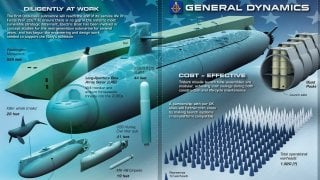The Navy's New Columbia-Class Missile Submarine Nightmare Is Here
The U.S. Navy’s Columbia-class submarines, designed to replace the aging Ohio-class vessels and maintain America’s sea-based nuclear deterrent, face significant delays and rising costs.
Summary and 4 Points You Need to Know: The U.S. Navy’s Columbia-class submarines, designed to replace the aging Ohio-class vessels and maintain America’s sea-based nuclear deterrent, face significant delays and rising costs.
-The first ship, USS District of Columbia, is now delayed by 12 to 16 months, primarily due to slower delivery of key components.
-With an estimated price tag rising by $1.7 billion for the lead ship, the Congressional Budget Office projects higher costs for subsequent vessels as well.
-Despite these challenges, the Columbia-class submarines, equipped with 16 missile tubes and advanced stealth technology, remain critical for maintaining U.S. nuclear deterrence in the face of growing adversarial threats.
$1.7 Billion Over Budget: The Columbia-Class Submarine’s Growing Price Tag
Considering the increasing hostility of America’s nuclear-armed adversaries, maintaining a technologically superior nuclear triad should be a top priority for policymakers. The ability to strike from land, air, and sea gives the U.S. the capability to respond to any nuclear attack with a barrage of its own nukes.
The U.S. Navy’s 14 Ohio-class submarines are currently responsible for America’s sea-based nuclear deterrent. Upcoming Columbia-class ships are designed to replace these aging vessels, and they are scheduled to enter service in the early 2030s.
Earlier this year, the Navy revealed that delivery of the first Columbia-class submarine is now expected to be delayed between 12 and 16 months. According to Bloomberg News and other outlets, delays affect the vessels’ bow section and power generators.
The Navy’s top civilian asserted in April that one of the most significant drivers of the delays is the slower delivery of a turbine generator constructed by Northrop Grumman. This news was detailed in a 45-day review conducted by Navy Secretary Carlos Del Toro.
An Overview of the Columbia-Class
Ohio-class submarines are the largest ships of their kind. Columbia-class boats will be even bigger. These vessels will measure 560 feet in length and displace nearly 21,000 tons, making them the largest and most complex submarines in history. The ships’ nuclear reactors will not require refueling during their planned lifetime service.
USS District of Columbia (SSBN-826) and USS Wisconsin (SSBN-827) are the only boats in this class ordered so far and will be followed by an additional 10 submarines. Electric Boat and Newport News Shipbuilding are constructing the ships from start to finish, as they are the only manufacturers in the country with the capacity to build nuclear-powered subs.
Few details about the Columbia class are unclassified, but some information has been shared. Each submarine in this class will be fitted with 16 missile tubes for launching Trident II D5 submarine-launched ballistic missiles. From boat nine onward, the remaining submarines will be equipped with an upgraded D5LE2 ballistic missile. Columbia-class submarines will boast enhanced acoustic performance and Mk 48 torpedoes. They will be extremely challenging for adversaries to detect.
What Is Hurting the Columbia-Class's Prospects
While the Columbia class is built for the essential task to manage the Navy’s deterrent, the hefty price tag keeps growing. The Navy projected this fall that the lead ship of the class will cost around $1.7 billion more than projected. The Congressional Budget Office further warned that the rest of the ships will cost roughly $1.5 billion more than intended. "CBO estimates that total shipbuilding costs would average about $34 billion to $36 billion (in 2023 dollars) over the next 30 years, which is about 16 percent more than the Navy estimates. Compared with its estimates for the 2023 plan, CBO's estimates increased by between 5 percent and 10 percent in real (inflation-adjusted) terms, depending on the alternative.”
These delays and cost increases are concerning, but falling behind the capabilities of increasingly aggressive U.S. adversaries would be a greater worry still. The timely introduction of the Columbia-class ships, along with the Navy’s other next-generation systems, is crucial.

About the Author: Maya Carlin, Defense Expert
Maya Carlin, National Security Writer with The National Interest, is an analyst with the Center for Security Policy and a former Anna Sobol Levy Fellow at IDC Herzliya in Israel. She has by-lines in many publications, including The National Interest, Jerusalem Post, and Times of Israel. You can follow her on Twitter: @MayaCarlin.
The main image is from General Dynamics. All other images are Creative Commons or Shutterstock.
From the Vault
Russia Freaked Out: Why the U.S. Navy 'Unretired' the Iowa-Class Battleships
Battleship vs. Battlecruiser: Iowa-Class vs. Russia's Kirov-Class (Who Wins?)


